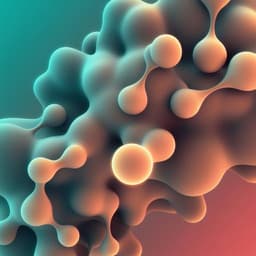
Health and Fitness
Joint associations between objectively measured physical activity volume and intensity with body fatness: the Fenland study
T. Lindsay, K. Wijndaele, et al.
This research, conducted by Tim Lindsay and colleagues, reveals a significant inverse relationship between physical activity energy expenditure (PAEE) and body fatness among middle-aged British adults. The study emphasizes the importance of engaging in any form of physical activity, highlighting that while vigorous-intensity activities can help reduce body fat, overall PAEE volume holds more significance.
~3 min • Beginner • English
Introduction
The study investigates how overall physical activity volume (PAEE) and the intensity profile by which that energy is accumulated jointly relate to body fatness. PAEE is the most variable and behaviorally modifiable component of total energy expenditure. Physical activity intensity is commonly expressed in METs, and the same PAEE can arise from different combinations of light, moderate, and vigorous activity. Prior research has linked physical activity with obesity and other health outcomes, but most analyses consider volume and intensity in parallel rather than integrated. Time-based isotemporal substitution models do not disentangle changes in volume that accompany reallocations to higher intensity. The authors therefore aim to evaluate, in a large free-living adult cohort, the integrated joint associations of objectively measured PAEE volume and intensity composition with body fatness, clarifying whether volume or intensity plays the primary role and quantifying any additional contribution of intensity beyond volume.
Literature Review
Prior studies show physical activity is associated with lower risk of obesity, metabolic diseases, and mortality. Time-based isotemporal substitution analyses suggest that replacing sedentary time with moderate-to-vigorous physical activity (MVPA) relates to better adiposity and cardiometabolic profiles. However, such models inherently increase PA volume when reallocating time to higher intensities, confounding volume and intensity effects. Integrated approaches akin to nutritional epidemiology, where total energy intake and macronutrient composition are modeled jointly, may better distinguish these dimensions. Previous compositional analyses have demonstrated inverse associations between MVPA time and adiposity, and longitudinal evidence in older adults links reallocations from MVPA to sedentary behavior with increased BMI and fatness. Trials comparing calorically matched high-intensity interval and moderate-intensity continuous training indicate similar adiposity benefits, underscoring the primacy of energy expenditure. This study extends the literature by integrating PAEE volume and energy-based intensity composition in a large population sample with objective PA and DXA-derived adiposity.
Methodology
Design and participants: Cross-sectional analysis within the Fenland study, an ongoing population-based cohort of adults aged 29–64 years recruited from general practices in the East of England (2005–2015). Inclusion for this analysis required valid physical activity monitoring and DXA-derived body composition. Final sample: 11,468 participants (6148 women, 5320 men). Ethics approval obtained; informed consent provided.
Body composition: Total body fat mass and percent body fat (BF%) measured by DXA (Lunar Prodigy, enCORE 14.10.022), validated against a 4-compartment model. Scanning precision CV ~2% for total fat mass (30 scans). Fat Mass Index (FMI = fat mass/height²) was a secondary outcome. Standard protocols used; symmetry method applied for large participants not fully fitting the field of view.
Physical activity assessment: Combined heart rate and uniaxial accelerometry (Actiheart) worn continuously for 6 days at 1-min resolution. Heart rate individually calibrated via treadmill test. Preprocessing and branched equation modeling combined heart rate and acceleration to estimate minute-by-minute PAEE (J min⁻¹ kg⁻¹) and derive MET intensities. Energy spent at each intensity was expressed as a fraction of total PAEE. Intensity categories: sedentary/sleep (SS <1.5 METs), light (LPA 1.5–3), moderate (MPA 3–6), vigorous (VPA >6). Sensitivity redefinition: LPA 1.5–4, MPA 4–7, VPA >7. For participants with zero MPA/VPA, minimal positive values were assigned for analyses requiring log-transformations.
Wear-time and data quality: Inclusion required ≥72 h total wear and ≥8 h cumulative wear in each quadrant of the day (to ensure coverage across the diurnal cycle). Records lacking any zero-acceleration epoch were excluded (device QC). Participants with missing DXA were excluded; those with minor artefacts or implants were retained.
Covariates: Self-reported demographics and lifestyle (age, sex, marital status, education, income, ethnicity, site, smoking); diet via validated FFQ estimating energy from macronutrients and alcohol; plasma vitamin C as a biomarker of fruit/vegetable intake (imputed when missing using age, sex, self-reported intake, supplementation). Missing categorical covariates were coded as separate categories. Participants without dietary info (n=6) were excluded from analyses.
Statistical analysis: Sex-stratified analyses in Stata 14. Multivariable linear regressions related PAEE and intensity measures to BF% and FMI, adjusted for socio-demographic and dietary covariates. Sequential regressions assessed the fraction of PAEE above thresholds from 1–11 METs while controlling for total PAEE. Integrated volume-intensity modeling used two isocaloric substitution approaches: (1) linear substitution modeling percentage of PAEE reallocated among SS, LPA, MPA, VPA while including total PAEE (percentage-point exchanges), and (2) compositional data analysis modeling isocaloric reallocations of active energy among intensities. Analyses were stratified by PAEE tertiles to compare the relative contributions of volume and intensity across activity levels. Sensitivity analyses used alternative intensity cut-points and FMI as the outcome. Results were presented as beta coefficients with 95% CIs; significance set at p<0.05.
Key Findings
- Sample: 11,468 adults (6148 women, 5320 men). Women had lower PAEE (mean 50 kJ/day/kg) than men (59 kJ/day/kg) and higher BF% (38% vs 28%). PAEE composition: women LPA 59%, MPA 27%, VPA 3%; men LPA 51%, MPA 35%, VPA 7% of PAEE.
- PAEE-volume associations: Higher PAEE was linearly and inversely associated with body fatness in both sexes.
• BF% per 1 kJ/day/kg PAEE: women beta −0.16 (95% CI −0.17, −0.15); men beta −0.09 (−0.10, −0.08).
• FMI (kg/m²) per 1 kJ/day/kg PAEE: women −0.07 (−0.08, −0.07); men −0.03 (−0.04, −0.03).
- Intensity composition beyond volume: Controlling for total PAEE, higher fractions of PAEE accumulated above higher MET thresholds were associated with progressively lower BF%, indicating added benefit of higher intensity accumulation.
- Linear isocaloric substitution (percentage of PAEE reallocated): For a fixed PAEE volume, reallocating energy to VPA from lower intensities was associated with lower BF%.
• Women (per 1 percentage-point PAEE reallocated): LPA→VPA −0.25 (−0.29, −0.20) %BF; MPA→VPA −0.24 (−0.29, −0.20) %BF; VPA→other intensities associated with higher BF% (e.g., VPA→any +0.25 (0.20, 0.29)). Total PAEE effect: −0.12 (−0.14, −0.11) %BF per 1 kJ/day/kg.
• Men: LPA→VPA −0.14 (−0.18, −0.10) %BF; MPA→VPA −0.12 (−0.18, −0.10) %BF; Total PAEE effect: −0.05 (−0.07, −0.04) %BF per 1 kJ/day/kg.
- Compositional isocaloric analysis: Reallocating active energy to VPA (drawing proportionally from other intensities) was associated with lower BF%; reallocating to LPA was associated with higher BF%; reallocating to MPA was not significant. Reallocation to SS was non-significant in women and unexpectedly associated with lower BF% in men (noted as a small reservoir and not a target for behavior change).
- Relative importance of volume vs intensity: The magnitude of the PAEE volume association exceeded that of intensity composition. Example in women: increasing PAEE from tertile 1 to tertile 2 (~+17 kJ/day/kg) corresponded to ~3 percentage-point lower BF%, whereas maximizing VPA proportion within tertile 1 (to the observed maximum) corresponded to ~1 percentage-point lower BF%. Combining both yielded ~4.5 percentage-point lower BF%.
- Findings were consistent when using FMI, alternative intensity cut-points (1.5–4/4–7/>7 METs), and across PAEE tertiles.
Discussion
The study demonstrates that overall physical activity volume (PAEE) is strongly and inversely associated with body fatness, confirming and extending prior evidence with objective PA and DXA measures in a large middle-aged cohort. While accumulating a greater share of active energy at vigorous intensities is additionally associated with lower body fatness, this effect is small relative to the dominant influence of total PAEE. These integrated energy-based models clarify the nested relationship between volume and intensity, avoiding the confounding present in time-based isotemporal analyses where reallocations to higher intensity inherently increase volume. The non-significant role of MPA and the positive association for LPA in isocaloric models should be interpreted in the context of fixed total PAEE, not as isolated effects. The small, paradoxical association of reallocating energy to sedentary intensity with lower BF% in men likely reflects the tiny size of that energy reservoir among highly active men and is not a realistic behavior-change target. Sex differences were observed, with stronger PAEE associations in women, possibly due to greater variance in adiposity and lower variance in PA; causality and mechanisms require testing in trials. Public health implications align with WHO guidance that every movement counts: increasing overall activity volume yields the largest benefit, while incorporating bouts of more vigorous effort can provide additional, albeit smaller, improvements. The energy-based framing suggests practical behavior changes, such as modestly increasing the effort of daily tasks and, where feasible, increasing total active energy expenditure, may effectively reduce body fatness.
Conclusion
Total physical activity energy expenditure and the intensity pattern by which it is accumulated are independently associated with body fatness in free-living adults. At similar PAEE levels, allocating a greater proportion of energy to vigorous intensities associates with lower body fatness; however, the magnitude of this intensity effect is secondary to that of overall volume. These findings support guidelines prioritizing increases in overall physical activity and endorsing that any movement confers benefit, with additional gains from incorporating higher-intensity efforts where feasible. Future research should include longitudinal studies and randomized trials to establish causality, explore biological mechanisms and sex differences, and evaluate practical interventions that modify both PAEE volume and intensity composition.
Limitations
- Cross-sectional design limits causal inference and directionality; residual confounding cannot be excluded despite extensive adjustment.
- Generalizability may be limited to similar populations (middle-aged adults in the East of England) despite PAEE comparability to national estimates.
- Dietary intake was self-reported (FFQ), subject to measurement error; vitamin C used as a biomarker but not comprehensive of diet quality.
- Physical activity intensity and PAEE were estimated via combined heart rate and acceleration with individual calibration; although validated, measurement error is possible. Minimal positive substitutions for zero MPA/VPA were used for transformations.
- Some participants lacked DXA at one site early in data collection; although drop-out analyses suggested no bias, missingness could still impact precision.
- The SS energy reservoir is very small in highly active individuals, making some modeled reallocations less practically feasible.
Related Publications
Explore these studies to deepen your understanding of the subject.







